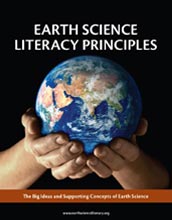News Release 09-119
New Report Sets Forth Principles of Earth Science Literacy

NSF and other organizations have released a report on earth science literacy importance.
June 4, 2009
This material is available primarily for archival purposes. Telephone numbers or other contact information may be out of date; please see current contact information at media contacts.
Earth's rocks and other materials provide a record of its history. Our solar system formed from a vast cloud of gas and dust 4.6 billion years ago. Earth's crust has two distinct types: continental and oceanic.
These and other concepts are the major ideas of Earth science that all citizens should know, according to a newly released report--Earth Science Literacy Principles: The Big Ideas and Supporting Concepts of Earth Science--funded by the National Science Foundation (NSF)-supported Earth Science Literacy Initiative (ESLI).
Even modest changes to Earth's systems have had profound influences on human societies and the course of civilization, according to the report. Understanding these systems and how they interact is vital for our survival, the report states.
"The Earth sciences have never been more important than they are today," says Robert Detrick, director of NSF's Division of Earth Sciences. "It's important that every citizen have knowledge of the fundamental concepts of Earth science such that he or she may make informed and responsible decisions about public issues--from climate change to energy, from natural resources to earthquake hazards.
"The Earth Science Literacy Initiative is a very important effort to convey this information about Earth science to the general public."
Earth science literacy is especially important at this time in history, echoes the report: "There are many challenges facing humanity--dwindling energy and mineral resources, changing climate, water shortages--directly relating to the Earth sciences. There are many difficult decisions that governments, local and national, will have to make concerning these issues. How well humans survive the twenty-first century will depend on the success of these decisions."
Earth Science Literacy Principles provides a summary of the major ideas in earth science for policy makers, educators, students and the general public.
The report complements the efforts of ocean, climate and atmospheric scientists, educators and others to define the ideas and concepts essential for a geoscience-literate public.
Earth Science Literacy Principles was developed through an online workshop held in May 2008, and a writing workshop held in July 2008.
The workshops brought together scientists from across the earth sciences, including mineralogists, petrologists, sedimentologists, paleontologists, geophysicists, geomorphologists, biogeochemists, volcanologists, geohazards specialists and hydrologists, among others.
The document has undergone review by leading scientists on each of the topics. Major geoscience and earth science education professional organizations have endorsed the report.
"Because of its validity, authority and succinct format, Earth Science Literacy Principles will be influential in a wide variety of scientific, educational and political domains," says Michael Wysession, chair of ESLI and a geoscientist at Washington University in St. Louis. "New textbooks and curricula are already being developed using the report."
As principle 9.9, the final one of the report, states, "An Earth-science-literate public, informed by a current and accurate understanding of the Earth, is critical to the promotion of good stewardship, sound policy and international cooperation."
For humans--and the planet on which they live--earth science literacy is a prerequisite to a successful future.
-NSF-
-
Lake Diablo in the Cascades illustrates Big Idea #4 - Earth is Continuously Changing.
Credit and Larger Version
Media Contacts
Cheryl Dybas, NSF, (703) 292-7734, email: cdybas@nsf.gov
Related Websites
Earth Science Literacy Initiative and Link to Report: http://www.earthscienceliteracy.org/
The U.S. National Science Foundation propels the nation forward by advancing fundamental research in all fields of science and engineering. NSF supports research and people by providing facilities, instruments and funding to support their ingenuity and sustain the U.S. as a global leader in research and innovation. With a fiscal year 2023 budget of $9.5 billion, NSF funds reach all 50 states through grants to nearly 2,000 colleges, universities and institutions. Each year, NSF receives more than 40,000 competitive proposals and makes about 11,000 new awards. Those awards include support for cooperative research with industry, Arctic and Antarctic research and operations, and U.S. participation in international scientific efforts.
Connect with us online
NSF website: nsf.gov
NSF News: nsf.gov/news
For News Media: nsf.gov/news/newsroom
Statistics: nsf.gov/statistics/
Awards database: nsf.gov/awardsearch/
Follow us on social
Twitter: twitter.com/NSF
Facebook: facebook.com/US.NSF
Instagram: instagram.com/nsfgov



